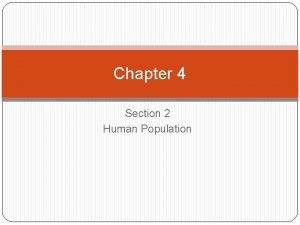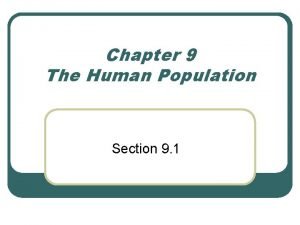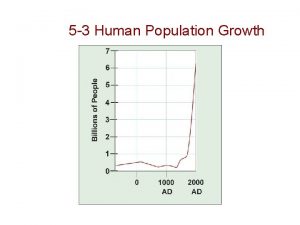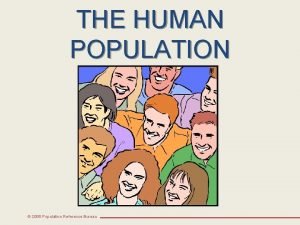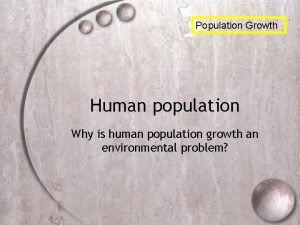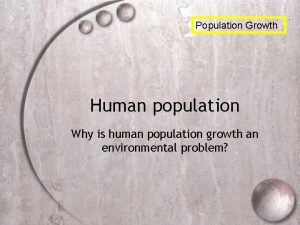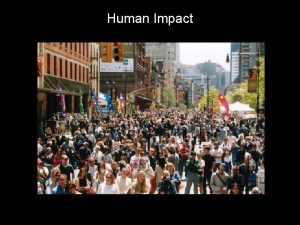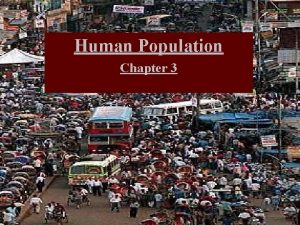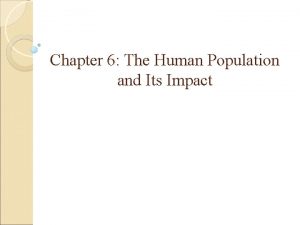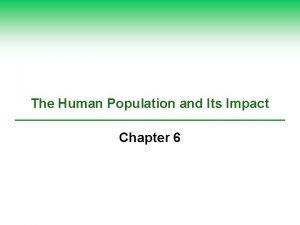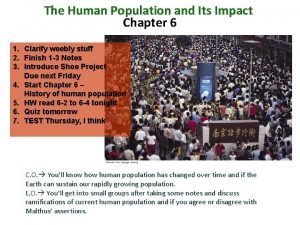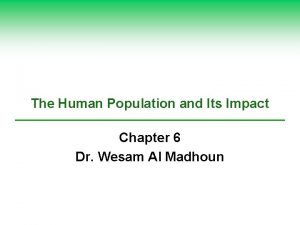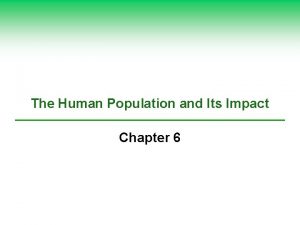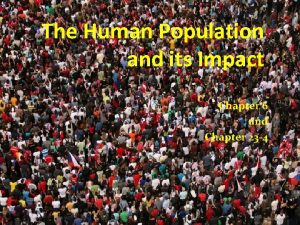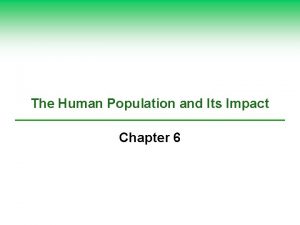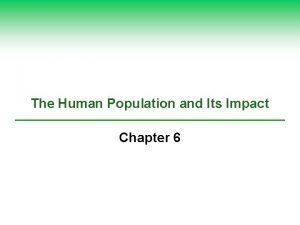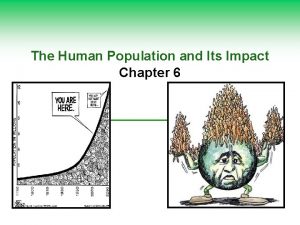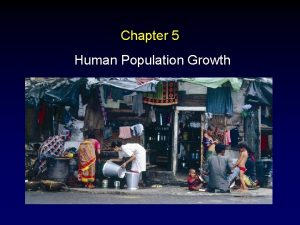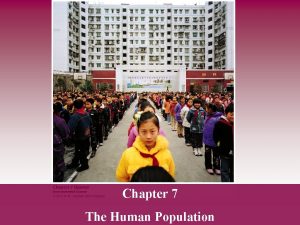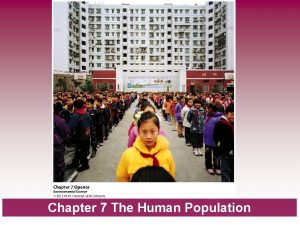The Human Population and its Impact Chapter 6

































- Slides: 33

The Human Population and its Impact Chapter 6

Human Exponential Growth • For the past 200 years, the human pop. has grown rapidly J-curve • Why? – ability to live in most climate zones and habitats – modern agriculture = more food – Improved sanitation and health care = drop in death rates

Annual Growth Rate • Global Pop. growth = 1. 21% per year • Growth is geographically uneven Fig. 6 -3, p. 127

Fig. 6 -4, p. 127

Cultural Carrying Capacity • Maximum # of people who could live in reasonable freedom and comfort indefinitely, without decreasing the ability of the earth to sustain future generations

Factors Affecting Human Population Size Ø Population change equation = (Births + Immigration) – (Deaths + Emigration) Ø Crude birth rate (CBR) - # live births per 1000 people in a population in a given year Ø Crude death rate (CDR) - # deaths per 1000 people in a population in a given year http: //smsh. dadeschools. net/science/aycart/apes. htm Population Change

http: //smsh. dadeschools. net/science/aycart/apes. htm Average CBR and CDR

Describing Population Changes ØDoubling Times - time (years) for a pop. growing at a specified rate to double in size - - EX: 2004 world’s pop. growth rate 1. 2% doubling time = 70/1. 2= 56 years http: //smsh. dadeschools. net/science/aycart/apes. htm Ø“Rule of 70”

Fertility • fertility rate = number of children born to a woman during her lifetime – replacement-level fertility rate = average number of children that couples in a pop. must bear to replace themselves – total fertility rate (TFR) = average number of children born to women in a pop. during their reproductive years

Fig. 6 -5, p. 130

US Fertility & Birth Rates 76 mil (1900) to 294 mil (2004) Fig. 6 -6, p. 131

Factors Affecting Birth Rates • Importance of children as a part of the labor force • Cost of raising and educating children • Availability of, or lack of, private and public pension systems • Infant deaths • Urbanization

Factors Affecting Birth Rates • Educational and employment opportunities available for women • Average at marriage (or average at which a woman has her first child) • Availability of legal abortions • Availability of reliable birth control methods • Religious beliefs, traditions, and cultural norms

Factors Affecting Death Rates • • • Increased food supplies and distribution Better nutrition Medical advances Improved sanitation Safer water supplies

Factors Affecting Death Rates Ø Life expectancy - avg. # years a newborn infant can expect to live Ø Infant mortality rate (IMR) - # babies out of every 1000 born who die before their 1 st birthday BAD NEWS Global life expectancy increased from Poorest, least developed countries 48 years to 69 years life exp. 57 years or less (may drop due to internal strife, AIDS) (77 developed; 67 developing) IMR dropped from 20 per 1000 live births to 7 in developed countries IMR dropped from 118 per 1000 live births to 61 in developing countries Most infants and children die from fully preventable causes http: //smsh. dadeschools. net/science/aycart/apes. htm GOOD NEWS

Essential Question 1. What are the factors that influence birth and death rates?

Migration • Movement of people into (immigration) and out of (emigration) specific geographic areas – Most seek jobs and economic improvement – Religious persecution, ethnic conflicts, political oppression, wars and certain types of environmental degradation cause some to migrate

Fig. 6 -11, p. 135

Age Structures • The numbers or percentages of males and females in young, middle and older age groups in that population – Prereproductive (0 -14) – Reproductive (15 -44) – Postreproductive (45 and older)

Fig. 6 -12, p. 136

Fig. 6 -13, p. 136

Essential Question 2. What is an age structure diagram and what can it be used for?

Slowing Human Population Growth • Promote economic development • Empower women • Promote family planning The Miniature Earth VHEMT

Promote Economic Development • Reduce poverty through economic development and universal primary education • Demographic transition = as countries become industrialized and economically developed, first their death rates decline and then their birth rates decline

Fig. 6 -17, p. 140

Stage 1: Preindustrial High birth rate High death rate Slow population growth Fig. 6 -17, p. 140

Stage 2: Transitional High birth rates LOW death rates High population growth Fig. 6 -17, p. 140

Stage 3: Industrial LOW birth rate Low death rate Slow population growth Fig. 6 -17, p. 140

Stage 4: Post-industrial Lower birth rate Stable death rate Declining population growth Fig. 6 -17, p. 140

Empower Women • Elevate the status of women • Women tend to have fewer children if they are – Educated – Have the ability to control their own fertility – Earn an income of their own – Live in societies that do not suppress their rights

Promote Family Planning • Family planning = provides educational and clinical services that help couples choose how many children to have and when to have them • Most provide info on birth spacing, birth control, and health care for pregnant women and infants • Reduces number of abortions and deaths of mom/babies during pregnancy

Promote Family Planning Problems • Many pregnancies are unplanned • Lack of access to services • Expand to include teenagers and sexually active unmarried women • Develop programs that educate men • Greatly increase research male birth control

Essential Question 3. What are the ways in which we can slow human population growth?
 Chapter 4 population ecology answer key
Chapter 4 population ecology answer key Chapter 4 population dynamics study guide answers
Chapter 4 population dynamics study guide answers Chapter 27 human impact on earth resources
Chapter 27 human impact on earth resources Chapter 16: human impact on ecosystems answer key
Chapter 16: human impact on ecosystems answer key Chapter 16 human impact on ecosystems
Chapter 16 human impact on ecosystems Renaissance characteristics
Renaissance characteristics Lesson 5 the slave trade and its impact on africa
Lesson 5 the slave trade and its impact on africa Chapter 4 section 2 human population
Chapter 4 section 2 human population Chapter 4 section 1 population dynamics answer key
Chapter 4 section 1 population dynamics answer key Chapter 9 the human population section 1
Chapter 9 the human population section 1 Population ecology section 1 population dynamics answer key
Population ecology section 1 population dynamics answer key Population ecology section 1 population dynamics
Population ecology section 1 population dynamics Chapter 8 human needs and human development
Chapter 8 human needs and human development Chapter 8 human needs and human development
Chapter 8 human needs and human development The emigree poem
The emigree poem Its halloween its halloween the moon is full and bright
Its halloween its halloween the moon is full and bright Human movement impact factor
Human movement impact factor Chile biomes
Chile biomes Human impact on lithosphere
Human impact on lithosphere Human impact on agriculture
Human impact on agriculture Carbon cycle human impact
Carbon cycle human impact Human impact on terrestrial ecosystems
Human impact on terrestrial ecosystems Desert biome
Desert biome Human impact on the tundra
Human impact on the tundra Human impact on beaches
Human impact on beaches Human impact on groundwater
Human impact on groundwater Lentic ecosystem
Lentic ecosystem Human impact on oceans
Human impact on oceans Human impact on oceans
Human impact on oceans Section 5-1 how populations grow answer key
Section 5-1 how populations grow answer key Section 5-3 human population growth
Section 5-3 human population growth Human population
Human population Generator human design type
Generator human design type Eugenic population policies definition ap human geography
Eugenic population policies definition ap human geography







